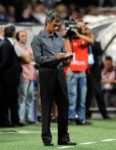This is an excerpt from the book Soccer Tactics 2014: What the World Cup taught us By Ray Power,you can buy it here.You can read the first part here
Defying Their Identity
With a World Cup you should never take anything for granted. Teams that you would expect to possibly win the tournament – fail early on! After all Spain, Italy and England (although they were maybe not true contenders) all exited the competition in the group stages losing two of their three opening games. There are also those, like Costa Rica and the USA, who qualify for the tournament’s knock-out stages, despite having been drawn in exceptionally difficult groups.
What you really do not expect to be writing about is how two nations with football entrenched in their psyche, and with a unique way of playing, can bend so much from their footballing identity. They did this however with winning, rather than sentiment in mind.
The Netherlands
It is hard to find a national footballing identity as strong at that found with the Netherlands. This identity is so fierce and so ingrained in the Oranje mindset that they have successfully exported it all over the world. Countless clubs and developing football countries, such as Ireland and Australia, have placed their national development programmes in the hands of Dutch coaches in an attempt to imitate the success of the Dutch coaching model, from youth through to professional football. We even find the legacy of the Dutch involvement in the Korean national team that has affected their national identity.
The quote at the start of the chapter from outspoken coach and fitness expert, Raymond Verheijen, shows just how much of an internal battle has raged in the Netherlands on the back of the 2014 World Cup. The Dutch public and media expect to see attractive football, seeped in the culture of Total Football that lit the world up in the 1970s under Rinus Michels. Their leading club, Ajax Amsterdam, also successfully implemented a system where technique and tactical fluency was, to them, the only way forward, and although the Godfather of Dutch football, Johan Cruyff, insists that winning is their first priority, one cannot help but feel that there is a national embarrassment to winning ugly – and many feel that winning is nothing without doing so in an entertaining manner.
The tactical approach of the Dutch at the 2014 World Cup was far removed from The Dutch Way. Not only did coach Louis van Gaal abandon his and the nation’s trusted 4-3- 3 formation in favour of a 3-4-1-2 (although not a system that is alien to the Dutch), he also chose to play a significant amount of this tournament without the ball. Staggeringly, only minnows Iran (29.7%) had less total possession than The Netherlands (39.5%) after their opening three groups games. Overall, The Netherlands were a lowly 20th when it came to overall possession at the 2014 World Cup (48.5%).
Instead of dominating possession, as is the Oranje trademark, they defended resolutely, pressed hard in midfield, and looked to hit their opponents with quick counter- attacks to allow their front pairing of Arjen Robben and Robin van Persie, with the assistance of Wesley Sneijder, to do their damage offensively. For van Gaal it was no longer about the Dutch being the flamboyant under-achievers (which has in itself almost become a footballing trait of the Dutch) – it was purely about winning.

Brazil
When you think of Brazil culturally, you think of colour, carnival, and smiles. When you think of Brazilian football, you think of wonderfully technical players, beach footballers from the favelas who could make fools of the best foreign players with their trickery, and a country that is passionate about their status at entertainers in world football. Consequently, when you think of Brazil at World Cup Finals, you think of flair, individuality, and a game firmly rooted in their flamboyant culture.
The Brazil we witnessed at their own World Cup however was far from that. They seemed rather more English in their set-up, although such a statement would probably never see me allowed to land in Rio or dare enter the Maracanã. Like van Gaal, Luis Felipe Scolari, chose the pursuit of ‘winning’ football over ‘Brazilian’ football – he chose function over flamboyance. Two holding midfield players were a constant, with Wolfsburg’s Luis Gustavo the main midfield destroyer, coupled with midfield workhorses, Paulinho, Fernandinho or occasionally Ramires. Against Mexico, attacking midfielder Oscar completed the most tackles in one game at the World Cup, with eight.
There is a legitimate suggestion that the team was built around Neymar, the so-called “golden boy” of the 2014 World Cup, with target strikers like Fred, and his usual replacement, Jo, designed to play high up against opposition centre-backs to allow Neymar more space to operate. You could be forgiven for assuming that the tactics were to allow Neymar to be the match-winner, and the others were there as the support-cast.
It was very common to see goalkeeper Julio Cesar choose to play longer, more direct passes to Fred / Jo, appearing less comfortable in taking calculated risks by building possession from the back. Prior to their last 16 encounter with Chile, word from the Brazilian camp was that they were seeking to use their height and physical advantage from set-plays as one of their main ploys to win the game – something you may be expected to hear from a functional mid-table English coach rather than a Brazilian World Cup winner! Their over-physical tactic of targeting Columbia’s James Rodriguez in their quarter -final match was a tragic cultural shift from when their very own Pelé was kicked around World Cup pitches decades before that.











Recent Comments